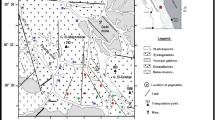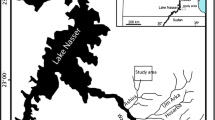Abstract
Gebel Filat granites form one of Egyptian younger granite intrusions in Wadi Allaqi region, South Eastern Desert of Egypt. They are perthitic monzogranites composed mainly of K-feldspars, plagioclase, and quartz with minor biotite. Plagioclase feldspars are Na-rich and have low anorthite content (An2–3). Potash feldspars are mainly perthitic microcline and have chemical formula as (Or96–96.6 Ab3.4–4 An0). Biotite is Mg-rich and seems to be derived from calc-alkaline magma. Chlorite is pycnochlorite with high Mg content, revealing its secondary derivation from biotite. The estimated formation temperatures of biotite and chlorite are (689–711°C) and (602–622°C), respectively. Gebel Filat monzogranites are metaluminous, high-K calc-alkaline, I-type granites. They are late orogenic granites related to subduction-related volcanic arc magmatism. They are enriched in LILE and depleted in HSFE indicating highly differentiation character. The REE patterns display an enrichment in LREE due to presence of zircon and allanite as accessories and depletion in HREE with slight negative Eu anomaly \( \left( {{\text{Eu}}/{\text{Eu}} * = 0.51 - 0.97} \right) \). The parent magma of Gebel Filat monzogranites were emplaced at moderate depths (20–30 km) under moderate conditions of water-vapor pressure (1–5 kbar) and crystallization temperature [700–750°C]. The source magma of these granites seems to be derived from partial melting of lower crust material rather than upper mantle. The geochemical characteristics of pegmatites revealed that they are related to post orogenic within plate magmatism and not genetically related to the parent magma of Gebel Filat monzogranites. Distribution of radioactive elements (U and Th) in the studied rocks indicates normal U–Th contents for Filat monzogranites and U–Th bearing pegmatites. The positive correlations of each of Zr and Y versus U and Th are attributed to presence of zircon and allanite as accessories which incorporate U and Th in their crystal lattice.
الملخص العربي
يعتبر جرانيت فلات أحد أشهر متداخلات الجرانيت الأحدث بمنطقة وادى العلاقى جنوب الصحراء الشرقية بمصر. وتتميز هذه المتداخلة بأنها من نوع المونزوجرانيت البرثيتى والذى يتكون أساساً من الفلسبار القلى والبلاجيوكليز والكوارتز مع قليل من البيوتيت. وقد أوضحت الدراسات المجهرية والمعدنية أن البلاجيوكلاز فلسبار غنى بالصوديوم مع نسبة ضئيلة من الأنورثيت، بينما وجد أن الفلسبار القلى يتمثل أساسا بالميكروكلين البرثيتى، فى حين بدا البيوتيت بأنه من النوع الغنى بالماغنسيوم (الناتج من مجما كلس قلية) وهذا يتشابه مع معدن الكلوريت الذى أوضحت دراسته أنه أيضا من النوع الغنى بالماغنسيوم وهذا يدلل على أنه ناتج ثانوى مشتق من البيوتيت ،وأوضحت الدراسات لكل من البيوتيت والكلوريت أن درجة حرارة كلاهما تتراوح بين (689-711 ºم) ، (602-622 ºم) على التوالى. يتميز مونزوجرانيت جبل فلات بأنه نشأ من صهارة كلس قلية ذات نسبة بوتاسيوم عالية ، من النوع النارى ذو الطبيعة ميتا ألومنيوم ، كما أن الخصائص التكتونية توضح أنه تكون فى بيئة الجزر البركانية المنزلقة فى المراحل المتأخرة من الحركات الأرضية ، وهذه المجما نشأت بالإنصهار الجزئى للمناطق العميقة من القشرة فى أعماق متوسطة (20-30 كم) وتحت ضغط متوسط (1-5 ك بار) وفى درجة حرارة متوسطة (700-750 ºم) . أوضحت الدراسات الجيوكيميائية تميز هذه الجرانيتات بثرائها بالعناصر الغير متوافقة (مثل البوتاسيوم والربيديوم والباريوم) بينما تكون فقيرة فى العناصر المتوافقة(مثل الزركونيوم والنيوبيوم والإيتريوم) وهذا يوضح أنها ذات طبيعة تمايز التبلور عالية نسبيا، وتوضح دراسة ثراء صخور الجرانيت بالعناصر الأرضية النادرة الخفيفة ويعزى هذا لوجود المعادن الثانوية مثل الزركون والألانيت ، بينما لوحظ الإفتقار بالعناصر الأرضية النادرة الثقيلة مع وجود شذوذ سلبى لعنصر الإريبيوم. وقد أوضحت خصائص توزيع العناصر الشحيحة الجيوكيميائية للبجماتيت - المصاحب لمتداخلات جرانيت جبل فلات - أنها تكونت من نشاط صهيرى فى مراحل مابعد الحركات الأرضية فى بيئة داخل الألواح القارية مما يؤكد أن هذه الصهارة ليس لها أى علاقة بمصدر الصهارة التى تكون منها مونزوجرانيت جبل فلات. وتبين دراسة توزيع العناصر المشعة (اليورانيوم والثوريوم) لكل من جرانيت فلات والبجماتيت المصاحب له أن جرانيت فلات به محتوى عادى من اليورانيوم والثوريوم ، بينما تتميز عروق البجماتيت بأنها ذات نسبة عالية من العناصر المشعة مقارنة بجرانيت فلات. وأظهرت العلاقات بين بعض العناصر الشحيحة مثل الزركونيوم والإيتريوم وكل من اليورانيوم والثوريوم تزايد تركيز اليورانيوم والثوريوم مع تزايد كل من الزركونيوم والايتريوم مما يؤكد ارتباط عميق مع الزركون والألانيت التى تكتنف هذه العناصر المشعة داخل تركيبها البلورى.








Similar content being viewed by others
References
Abdel Rahman AM (1994) Nature of biotites from alkaline, calc-alkaline and peraluminous magmas. J Petrol 35:525–541
Abdelsalam MG, Stern RJ (1996) Sutures and shear zones in the Arabian-Nubian shield. J Afr Earth Sci 23:289–310
Akaad MK, Noweir AM (1980) Geology and lithostratigraphy of the Arabian Desert orogenic belt of Egypt between Lat. 25° 35′ and 26° 30′N. Inst App Geol Bull Jeddah 3(4):127–136
Bentor YK (1985) The crustal evolution of the Arabo-Nubian Massif with special reference to the Sinai Peninsula. Precambrian Res 28:1–74
Berhe SM (1990) Ophiolites in Northeast and East Africa: implications for Proterozoic crustal growth. J Geol Soc London 147:41–57
Bettison LA, Schiffman P (1988) Compositional and structural variations of phyllosilicates from the Point Sal ophiolite, California. Am Mineral 73:62–76
Cathelineau M (1987) U-Th-REE mobility during albitization and quartz dissolution in granitoids: evidence from south-east French Massif Central. Bull Mineral 110:249–259
Chappell BW, White AJR (1974) Two contrasting granite types. Pacific Geol 8:173–174
Condie KC (1973) Archean magmatism and crustal thickening. Geol Soc Amer Bull 84:2981–2991
Deer WA, Howie RA, Zussman J (1966) An introduction to rock forming minerals. Longmans, London 517p
El Gaby S (1975) Petrochemistry and geochemistry of some granites from Egypt. N Jb Miner Abh 124:147–189
El Gaby S, Khudeir AA, Youssef M, Kamal El Din G (1988) Low pressure metamorphism in Hammamat sediments at Um Had area, Central Eastern Desert, Egypt. Bull Fac Sci Assuit Univ 17:51–71
El Gaby S, List F, Tehrani R (1990) The basement complex of the Eastern Desert and Sinai. In: Said R (ed) The geology of Egypt. Balkema, Rotterdam, pp 175–184
El Kazzaz YA (1995) Tectonic and mineralization of Wadi Allaqi, South Eastern Desert, Egypt. Ph.D. Univ. of Luton, England, UK, 220p
El Kazzaz YA (1996) Speculations on the tectonic Evolution of Central Wadi Allaqi, South Eastern Desert, Egypt. Proceedings of the Egyptian Geol Surv, Centennial Confer (1896–1996), Cairo, 19–22 Nov., 205–223
El Kazzaz YA, Taylor WEG (1996) A tectonic-stratigraphy of Neoproterozoic in Wadi Allaqi, South Eastern Desert, Egypt. Proceedings of the Egyptian Geol Surv, Centennial Confer (1896–1996), Cairo, 19–22 Nov., 225–262
El Kazzaz YA, Taylor WEG (2001) Tectonic evolution of the Allaqi shear zone and implication for the Pan African terrain amalgamation in the south Eastern Desert of Egypt. J Afr Earth Sci 33(2):177–197
El Sayed MM (1998) Tectonic setting and petrogenesis of the Khadabora pluton: a Late Proterozoic anorogenic A-type younger granitoid in the Egyptian Shield. Chem Erde 58:38–63
Farag SS (1999) The basement rocks of Gebel Felat area and its radioactivity, South Eastern Desert of Egypt. Ph.D. Thesis, Fac of Sci, Cairo Univ., 308 p
Greiling RO, Abdeen MM, Dardir AA, El-Akhal H, El-Ramly MF, Kamal El-Din G, Osman AF, Rashwan AA, Rice AHN, Sadek MF (1994) A structural synthesis of the Proterozoic Arabian-Nubian Shield in Egypt. Geol Rundsch 83:484–501
Hassan MA, Hashad AH (1990) Precambrian of Egypt. In: Said R (ed) The geology of Egypt. Balkema, Rotterdam, pp 201–245
Henry DJ, Guidotti CV, Thomson JA (2005) The Ti-saturation surface for low-to-medium pressure metapelitic biotite: implications for geothermometry and Ti-substitution mechanisms. Am Mineral 90:316–328
Hey MH (1954) A new review of the chlorites. Mineral Mag 30:277–292
Hussein AA, Ali MM, El Ramly MF (1982) A proposed new classification of the granites of Egypt. J Volcanol Geotherm Res 14:187–198
Johannes W, Holtz F (1996) Petrogenesis and experimental petrology of granitic rocks. Minerals and Rocks Series 22. xiii + 335 pp. Berlin, Springer
Jowett EC (1991) Fitting iron and magnesium into the hydrothermal chlorite geothermometer—Geological Association of Canada/Economic Geology Joint Annual Meeting, Toronto, 1991. Program Abstr 16:A62
Kamel AF (1997) Structures controlling U and Th mineralization in the Gebel Felat area of the south Eastern Desert of Egypt. J Afr Earth Sci 24(4):649–652
Kazzaz YA (1998) Tectonic setting of granite intrusions in the Central Wadi Allaqi area, South Eastern Desert, Egypt. Ann Geol Surv Egypt XXI:385–394
Kroner A, Greiling RO, Rieschmann T, Hussein IM, Stern RJ, Durr S, Kruger J, Zimmer M (1987) Pan-African crustal evolution in the Nubian segment of northeast Africa. In: Kroner A (ed) Proterozoic lithospheric evolution. Geodyn Ser Am. Geophys Union 17:235–257
Le Maitre RW (1989) A classification of igneous rocks and glossary of terms. Blackwell, Oxford 193 p
Nachit H, Razafimahefa N, Stussi JM, Carron JP (1985) Composition chimique des biotites et typologie magmatique des granitoides. Comtes Rendus Hebdomadaires de l’ Academie des Sciences, Paris 301(11):813–822
Noweir AM, Sewifi BM, Abu El Ela AM (1990) Geology, petrography and petrogenesisof the Egyptian younger granites. Qatar Univ Sci Bull 10:363–393
Pearce JA (1996) Sources and settings of granitic rocks. International Geoscience New Magazine 19(4):120–125
Pearce JA, Harris NBW, Tindle AG (1984) Trace element discrimination diagrams for the tectonic interpretation of granitic rocks. J Petrol 25:956–983
Roberts MP, Clemens JD (1993) Origin of high-potassium, calc-alkaline I-type granitoids. Geology 21:825–828
Rogers JJW, Adams JAS (1969) Uranium and thorium. In: Wedepohl KH (ed) Handbook of geochemistry, II-3: 92-B-1 to 92-0-8 and 90-B-1 to 90-0-5. Springer
Rogers JJW, Greenberg JK (1981) Trace elements in continental margin magmatism: Part 3—alkali granites and their relationship to cratonization. Geol Soc Am Bull 92:6–9
Rogers JJW, Greenberg JK (1990) Late-orogenic, post-orogenic, and anorogenic granites: distinction by major-element and trace-element chemistry and possible origins. J Geol 98:291–309
Shackleton RM (1994) Review of Late Proterozoic sutures, ophiolitic melanges and tectonics of eastern Egypt and north-east Sudan. Geol Rundsch 83:537–546
Shaw DM (1968) A review of K-Rb fractionation trends by covariance analyses. Geochim Cosmochim Acta 32:573–601
Smith JV, Brown WL (1988) Feldspar minerals 1—crystal structures, physical chemical and micro-textural properties. Springer, Berlin, p 828 p
Stern RJ, Gottfried D (1986) Petrogenesis of late Precambrian (575n600 Ma) bimodal suite in northeast Africa. Contrib Mineral Petrol 92:492–501
Stern RJ, Hedge CE (1985) Geochronologic and isotopic constraints on late Precambrian crustal evolution in the Eastern Desert of Egypt. Am J Sci 258:97–127
Stone M (1992) The Tregonning granite: petrogenesis of Li-mica granites in the Cornubian batholith. Miner Mag 56/383:141–155
Takla MA, Sayyah TA, Hamimi Z, Mansour S, Farag SS (1994) Geologic setting and tectonic evolution of Gabal Felat area, South Eastern Desert, Egypt. Egypt J Geol 38(2):455–474
Taylor RS (1965) The application of trace elements data to problems in petrology. Phys Chem Earth 6:133–213
Taylor SR, McLennan SM (1985) The continental crust: its composition and evolution. Blackwell, Oxford
Taylor WE, El Kazzaz YA, Rashwan AA (1993) An outline of the tectonic framework for the Pan-African orogeny in the vicinity of Wadi Um Relan area, South Eastern Desert, Egypt. In: Thorweihe U, Schandelmeier H (eds) Geoscientific Research in northeast Africa, 31–34
Watson EB, Harrison MT (1983) Zircon saturation revisited: temperature and composition effects in a variety of crustal magma types. Earth Planet Sci Lett 64:295–304
Whalen JB, Currie KL, Chappell BW (1987) A-type granites: geochemical characteristics, discrimination and petrogenesis. Contrib Mineral Petrol 95:407–419
Zen E (1988) Tectonic significance of high-pressure plutonic rocks in the western Cordillera of North America. In: Ernst WG (ed) Metamorphism and crustal evolution of the western United States. Prentice-Hall, Englewood Cliffs, pp 41–67 Rubey, VII
Acknowledgement
The authors would like to express their sincere thanks to Prof. Abdalla, H.M. who facilitated the access to the electron microprobe analyses during his post doctoral fellowship at Hokkaido University, Japan. Special thanks are due to Prof. Hassaan, M.M. for his critical reviewing and insightful comments on the draft of this manuscript.
Author information
Authors and Affiliations
Corresponding author
Rights and permissions
About this article
Cite this article
Moghazy, N.M., Emam, A.A. & Abdel Rahman, E.M. Mineral chemistry and geochemical aspects of Gebel Filat granites, South Eastern Desert, Egypt. Arab J Geosci 4, 689–702 (2011). https://doi.org/10.1007/s12517-009-0073-x
Received:
Accepted:
Published:
Issue Date:
DOI: https://doi.org/10.1007/s12517-009-0073-x




